

The disappeared: Chicago police detain Americans at abuse-laden 'black site' The Chicago police department operates an off-the-books interrogation compound, rendering Americans unable to be found by family or attorneys while locked inside what lawyers say is the domestic equivalent of a CIA black site.
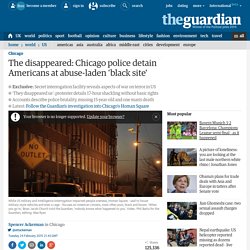
The facility, a nondescript warehouse on Chicago’s west side known as Homan Square, has long been the scene of secretive work by special police units. Interviews with local attorneys and one protester who spent the better part of a day shackled in Homan Square describe operations that deny access to basic constitutional rights. Alleged police practices at Homan Square, according to those familiar with the facility who spoke out to the Guardian after its investigation into Chicago police abuse, include: At least one man was found unresponsive in a Homan Square “interview room” and later pronounced dead. Being Real Black for You: Who Kendrick Lamar Is Rapping to on ‘The Blacker the Berry’ «
The Fear Factor - Lincoln Caplan. Cover Story - Summer 2014 Print Long-held predictions of economic chaos as baby boomers grow old are based on formulas that are just plain wrong Photoillustration by David Herbick By Lincoln Caplan For the past half century, the biggest demographic changes in the United States have often reflected the stages of life for the 76 million baby boomers.

The Danger of Telling Poor Kids That College Is the Key to Social Mobility - Andrew Simmons. Higher education should be promoted to all students as an opportunity to experience an intellectual awakening, not just increase their earning power.

Homeless Coder and the Cult of Entrepreneurship. Last summer, a 23-year-old computer programmer named Patrick McConlogue undertook a modern version of the Pygmalion project.
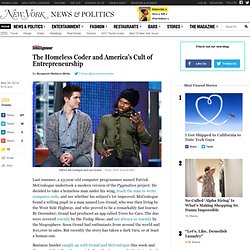
He decided to take a homeless man under his wing, teach the man to write computer code, and see whether his subject's lot improved. McConlogue found a willing pupil in a man named Leo Grand, who was then living by the West Side Highway, and who proved to be a remarkably fast learner. By December, Grand had produced an app called Trees for Cars. The duo were covered warmly by the Today Show, and not always so warmly by the blogosphere.
Www6.svsu.edu/~jalewis2/HIST1700/PDF/HIST 1700 Zinn Voices of Peoples History Reader.pdf. Faculty.catawba.edu/jmbitzer/War/TextAnnotation.pdf. TED Radio Hour: Where Ideas Come From. TED Radio Hour: Matt Ridley: What Happens When Ideas Have Sex? TED Radio Hour: Susan Cain: How Do Introverts Share Ideas? What is Rhetoric?
Poetry. Understanding Formal Analysis. The elements of art are components or parts of a work of art that can be isolated and defined.

They are the building blocks used to create a work of art. The list below describes each element of art. Learn about the principles of design here. Download a student handout containing a list of the elements of art and their definitions. (PDF, 168KB) Line A line is an identifiable path created by a point moving in space. Horizontal lines suggest a feeling of rest or repose because objects parallel to the earth are at rest. Vertical lines often communicate a sense of height because they are perpendicular to the earth, extending upwards toward the sky. Horizontal and vertical lines used in combination communicate stability and solidity. Diagonal lines convey a feeling of movement. The curve of a line can convey energy. Shape and form Shape and form define objects in space. Shape has only height and width. Form has depth as well as width and height. Space Real space is three-dimensional.
Color Texture. Brené Brown: The power of vulnerability. Making Mistakes. Brené Brown on Vulnerability. Open Yale Courses. Is not available. My Kinsman, Major Molineux - by Nathaniel Hawthorne. What Do Chinese Students Think of American History? - David Caragliano.
When a Fulbright scholar arrived in China to teach U.S. history, she encountered students who interpreted the subject in surprising ways.

A map of the United States, in Chinese. (Wikimedia Commons) White male privilege, genocide against Native Americans, slavery and subsequent racial oppression, exploitation of immigrants and laborers, repression of women and homosexuals, and environmental destruction -- teaching American cultural history through a post-modern lens is hardly the most obvious way to promote positive feelings toward the United States. Yet that is precisely what Amy Werbel did during her Fulbright year in China. "We were not going to China to make the United States look better than it is -- but rather to share what it feels like to be in a classroom in which everyone is free to scrutinize history without fear," explains Werbel. Teaching critical thinking is no small feat in any cultural context, but China poses particular challenges. "Get Lucky" by Daft Punk in different eras: listen. (AUDIO)
Bellows, Pennsylvania Station Excavation, c. 1907-8. American Civics.
Great Depression/New Deal. Shane Koyczan: "To This Day" ... for the bullied and beautiful. Industrial Age. Www.nytimes.com/packages/pdf/politics/20051022_FEMA2.pdf. Faces of America. South Africa. Civil War. The Dangerous, False Trade-Off Between Liberty and Security - Conor Friedersdorf. The NYPD's program of spying on Muslim Americans was excused as necessary for safety -- but it turns out it hasn't generated a single lead.
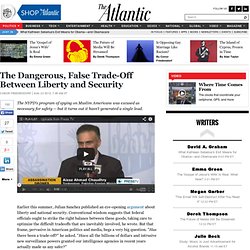
Earlier this summer, Julian Sanchez published an eye-opening argument about liberty and national security. Conventional wisdom suggests that federal officials ought to strike the right balance between these goods, taking care to optimize the difficult tradeoffs that are inevitably involved, he wrote. But that frame, pervasive in American politics and media, begs a very big question.
SA-I-GU: From Korean Women's Perspectives. This live-action documentary, which was broadcast nationally on PBS' "P.O.V.
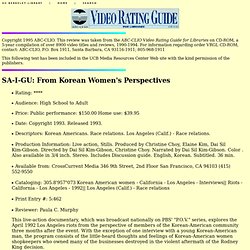
" series, explores the April 1992 Los Angeles riots from the perspective of members of the Korean-American community three months after the event. With the exception of one interview with a young Korean-American man, the program consists of the little-heard thoughts and feelings of Korean-American women shopkeepers who owned many of the businesses destroyed in the violent aftermath of the Rodney King decision. Using news footage, family and newspaper photographs, and current footage of the Korean-American community in Los Angeles coupled with English subtitles and voice-over narration, the video allows these women to tell their stories of the riots, which they call SA-I-GU. Using both Korean and English, they talk about how they came to America to find the American Dream for themselves and their families.
A Stag at Sharkey's. “The retired heavyweight boxer "Sailor" Tom Sharkey ran "stags," that is, illegal prizefights for all-male audiences, in the cellar of his saloon at Broadway and 65th Street on Manhattan's Upper West Side.
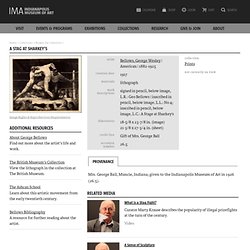
Humanities in the Twenty-First Century. Bill Smoot teaches English at the Castilleja School in Palo Alto, California.
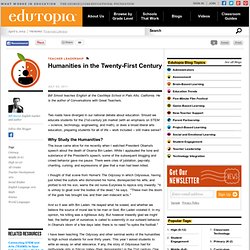
He is the author of Conversations with Great Teachers. Two roads have diverged in our national debate about education. Should we educate students for the 21st-century job market (with an emphasis on STEM -- science, technology, engineering, and math), or does a broad liberal arts education, preparing students for all of life -- work included -- still make sense? Why Study the Humanities? The issue came alive for me recently when I watched President Obama's speech about the death of Osama Bin Laden.
Colonial/Revolutionary America. Writing.